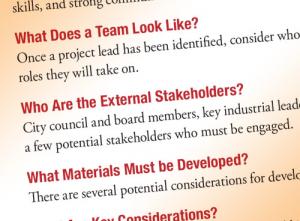Public Power
Paul Zummo is Director of Research and Policy Analysis at American Public Power Association. For over a decade he has been responsible for research on issues such as demand response, time-of-use rates, smart grid, data privacy and distributed generation, and has written white papers on current policy developments affecting the electric utility business as whole and how they impact public power utilities specifically. He produces annual statistical publications and analyzes industry trends and statistics.
Juliet Shavit is the President of SmartMark Communications, LLC and the Founder of SmartEnergy IP. For more than two decades, she has been at the forefront of conversation around technology innovation and the impact of those decisions on industry transformation. She is the founder of the Smart Grid Customer Education Symposium and US Department of Energy Smart Grid Customer Education Working Group.
Smart cities have become a buzzing topic in the past few years. There would seem to be a natural fit for public power utilities, which are generally overseen and owned by local governments, to be active participants in smart city initiatives.

Indeed, some public power utilities have undertaken bold smart city plans, though many utilities have taken a wait-and-see approach until now. As the trade association representing public power utilities, the American Public Power Association has offered a roadmap for public power utilities considering getting involved in smart cities. The roadmap lays out key questions utilities need to ask before developing a program and offers a path for utilities to take.
Before looking at the key questions, we must define what we mean by smart city. Today, the definition of smart cities is not universally agreed upon. For example, it can refer to a city that focuses on carbon reduction or is introducing electric vehicles.
It could also refer to a city that has implemented municipal Wi-Fi or integrated solar and distributed energy resources. Many utilities identify smart city initiatives as the next phase of smarter grid efforts, piggybacking on advanced metering infrastructure investments and deployments.
As defined in the roadmap, the Association defines smart as the intersection of digital with intelligence. Smart city, therefore, refers to a city that leverages digital connectivity and data analytics to drive intelligent decision making.
 Paul Zummo: There needs to be accountability, and the person in charge of this initiative must have control over people and processes at the utility, possess strong leadership and management skills, and strong communication skills.
Paul Zummo: There needs to be accountability, and the person in charge of this initiative must have control over people and processes at the utility, possess strong leadership and management skills, and strong communication skills.
In short, a smart city is a city that betters the lives of residents and businesses through mindful investments and deployments of advanced technologies. Specifically, these efforts can improve energy efficiency, reduce carbon emissions and improve reliability and customer service.
Having identified what a smart city means, the fundamental question the utility must then ask is, will this investment improve the community and the lives of the people in it? Going back to the original definition of smart, it also means asking if each technology decision is an intelligent and meaningful investment for customers and the community.
If the utility answers in the affirmative, then it must begin devising a plan. The roadmap lays out five questions to ponder before establishing a smart city program.
Who is Best to Lead?
There needs to be accountability, and the person in charge of this initiative must have control over people and processes at the utility, possess strong leadership and management skills, and strong communication skills. It doesn't matter if it's the CEO or someone else in the organization, but there must be someone with the vision to lead and follow through.
What Does a Team Look Like?
 Juliet Shavit: From an operations standpoint, the utility should identify concerns and a process for the development of a smart city security plan.
Juliet Shavit: From an operations standpoint, the utility should identify concerns and a process for the development of a smart city security plan.
Once a project lead has been identified, consider who else will be on the team and what roles they will take on. There should be a process lead — someone who will be responsible for developing schedules and core functions and processes. Someone should also manage regulatory and stakeholder communications to ensure these groups are looped into the process. Communications support will be critical in developing public-facing materials and managing public relations.
Who Are the External Stakeholders?
City council and board members, key industrial leaders, and consumer advocates are just a few potential stakeholders who must be engaged. Once these stakeholders have been identified, then the public power utility must determine what the engagement looks like, whether this engagement is formal or informal, how frequently to engage with key stakeholders, and what level of engagement is recommended and when.
What Materials Must be Developed?
There are several potential considerations for developing materials. It is advisable to develop a smart city mission statement with goals as identified by the utility that align with enhanced grid infrastructure efforts.
The utility and the city might want to establish clean energy and reduced carbon emission goals, develop an external communications plan to support community buy-in, outline project costs and a funding plan, and identify key milestones and metrics for the next five to ten years. A projected timeline by phases, which is a living document that starts with the utility's operating plan and budget, which then is reviewed by the project management office, would be beneficial as well.
What Are Key Considerations?
From an operations standpoint, the utility should identify concerns and a process for the development of a smart city security plan. The roadmap also suggests identifying key areas of automation that are currently part of smarter grid efforts and any alignments with the smart city model, as well as to identify opportunities to leverage current and future infrastructure for smart city efforts. The utility should also look at the overall goals of the smart city plan to see where the utility can contribute in areas of lifestyle and convenience.
Once a utility has answered these questions, it can develop a clear map to guide the city and the utility on the road to becoming a smart city.



